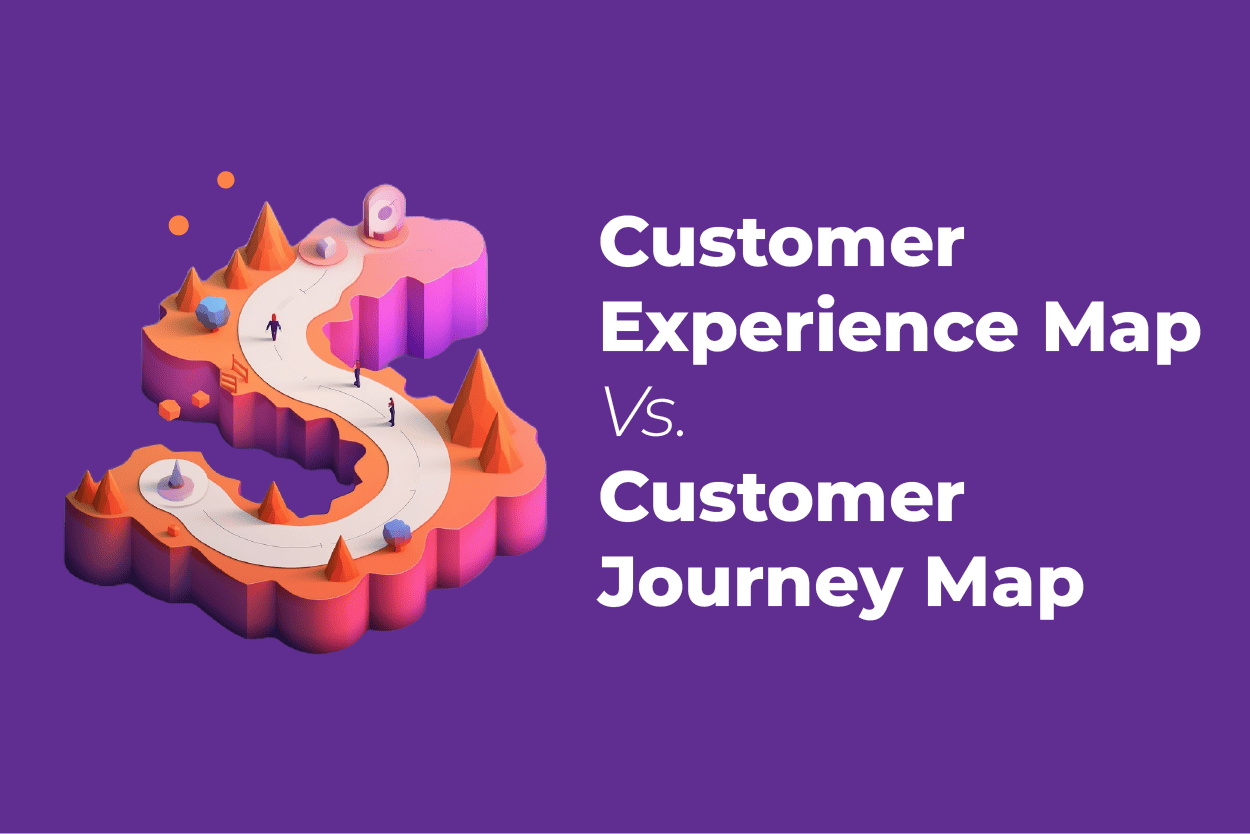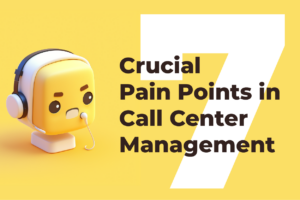Both the customer experience map and the journey map are essential tools for businesses aiming to understand and improve the interactions their customers have with their brand. While they often are used interchangeably, these maps serve distinct purposes, have unique elements, and offer varying insights. Let’s delve deep into the nuances of each to clarify their significance.
What is a Customer Experience Map?
The customer experience map is a powerful tool that allows businesses to gain a comprehensive understanding of customer interactions with their brand or service. It provides a holistic view of the entire customer journey, starting from the initial awareness phase and continuing through to the loyalty phase.
With Customer Experience Maps, we chart a course toward unrivaled customer satisfaction, operational efficiency, and enduring customer relationships – all essential treasures on the path to service excellence. – Christian Montes, Executive Vice President of Client Operations @NobelBiz
Key Components of a Customer Experience Map:
Touchpoints
These touchpoints are the various points of interaction between the customer and the brand. They can include activities such as visiting a website, reading a product review, or engaging with customer service. Each touchpoint is an opportunity for the brand to make an impression and create a positive customer experience.
- IVR (Interactive Voice Response) system for initial call routing.
- Agent-assisted support via phone.
- Self-service web portal for issue resolution.
- Chat support for real-time assistance.
- Email communication for query handling.
- Social media engagement for customer feedback.
- Post-interaction surveys to gather insights.
- Loyalty program enrollment for customer retention.
Channels
The channels refer to the mediums through which these interactions take place. In today’s digital age, customers can engage with brands through a wide range of channels, including social media platforms, email, and more. Understanding the different channels and how they contribute to the overall customer experience is crucial for businesses seeking to optimize their interactions.
- Phone
- Website
- Mobile app
- Chat platform
- Social media platforms (Facebook, Twitter, LinkedIn, etc.)
- SMS text messaging
- In-person (for retail contact centers)
Of course, the easy way of deploying, managing and tracking all these channels is to opt for a cloud contact center platform such as NobelBiz OMNI+ that allows full omnichannel operability.
This webinar episode (Transitioning from Voice-Only to an Omnichannel Contact Center) is dedicated to contact center decision-makers who are considering omnichannel technology. We will look at what it takes to implement an omnichannel solution and how it can help expand the scope of a contact center beyond the voice-only comfort zone.
Opportunities
The customer experience map also identifies areas of improvement and potential opportunities to enhance the overall customer experience. By analyzing the map, businesses can pinpoint areas where they can make changes or implement strategies that will positively impact customer satisfaction and loyalty.
- Personalized recommendations during IVR interactions.
- Proactive chat support offering help during website navigation.
- Sending order confirmations via email.
- Addressing social media comments to resolve issues.
- Encouraging post-call surveys to gather feedback.
- Providing exclusive offers through loyalty programs.
- Leveraging SMS for appointment reminders.
- Offering in-person support at physical locations for complex inquiries.
By using a customer experience map, businesses can gain a deeper understanding of their customers’ needs, expectations, and pain points. This valuable insight allows them to tailor their marketing, sales, and service strategies to better meet customer demands. Furthermore, by optimizing touchpoints and addressing pain points, businesses can foster trust and loyalty, ultimately leading to increased customer retention and higher lifetime value.
What is a Customer Journey Map?
A customer journey map is a visual representation of the process a customer undergoes to achieve a specific goal with a brand. It provides a detailed understanding of the customer’s experience at each stage, highlighting their emotions, pain points, and critical interactions that shape their relationship with the brand.
Customer Journey Maps are the compass for contact centers, guiding them to meaningful touchpoints, personalized channels, and countless opportunities to enhance customer experiences and drive operational excellence. – Brad Butler, Contact Center Software Consultant @NobelBiz
Key Components of a Customer Journey Map
Stages
The customer journey map breaks down the customer’s interaction process into defined steps or stages. These stages can include awareness, consideration, purchase, and post-purchase. Each stage represents a significant milestone in the customer’s journey towards their goal.
Goals
At each stage, customers have specific objectives or outcomes they aim to achieve. These goals can vary depending on the customer’s needs and preferences. For example, during the awareness stage, the goal may be to gather information about the brand, while during the consideration stage, the goal may shift towards evaluating different options.
Pain Points
Throughout their journey, customers may encounter challenges or barriers that hinder their progress. These pain points can arise from various factors, such as a lack of information, a confusing user interface, or poor customer service. Identifying and addressing these pain points is crucial for improving the overall customer experience.
Moments of Truth
The customer journey map identifies critical interactions, known as moments of truth, that can significantly impact the customer’s relationship with the brand. These interactions can be positive or negative, and they often occur at key touchpoints. Moments of truth can include the first impression of the brand, the ease of the purchasing process, or the level of customer support received.
Check out this great article on crucial pain points in call center management. Unlock the secrets to successful call center operations with this insightful article. Explore the hidden challenges that impact efficiency and discover practical solutions to navigate the ever-evolving landscape of technology, training, and customer data security.
By mapping the customer journey, businesses can gain valuable insights into the customer’s perspective and better understand their needs, preferences, and pain points. This understanding allows businesses to tailor their strategies and touchpoints to create a seamless and enjoyable experience for their customers.
Customer Experience Map Vs. Customer Journey The overlap and distinctions
While both maps focus on customer interactions, they have different scopes and objectives.
The customer experience map provides a comprehensive view of all possible interactions a customer can have with a brand. It takes into account every touchpoint, channel, emotion, and opportunity for improvement. This map allows businesses to gain a holistic understanding of the customer journey from start to finish, from the initial awareness phase to the loyalty phase. By analyzing the customer experience map, businesses can identify pain points, optimize touchpoints, and create a positive and memorable customer experience. This, in turn, fosters trust and loyalty, leading to increased customer retention and higher lifetime value.
On the other hand, the customer journey map is more goal-oriented, focusing on specific interactions that lead to a desired outcome. It breaks down the customer’s interaction process into defined stages, such as awareness, consideration, purchase, and post-purchase. At each stage, the customer has specific goals they aim to achieve. By mapping the customer journey, businesses can gain a detailed understanding of the customer’s experience at each stage, including their emotions, pain points, and critical interactions. This insight allows businesses to tailor their strategies and touchpoints to create a seamless and enjoyable experience for their customers. By addressing pain points and optimizing moments of truth, businesses can foster trust and loyalty, ultimately improving customer satisfaction and retention.
The benefits of mapping the customer experience and journey
Firstly, businesses gain enhanced understanding of customer behaviors, needs, and pain points. This insight helps in developing more effective marketing, sales, and service strategies that are aligned with customer expectations. By addressing pain points and optimizing touchpoints, brands can strengthen their relationships with customers, fostering trust and loyalty. A superior customer experience often leads to increased customer retention and higher lifetime value, translating into increased revenue for the business.
Understanding the overlap and distinctions between the customer experience map and the journey map is crucial for businesses aiming to improve their customer interactions. Both maps offer unique insights and benefits, allowing businesses to tailor their strategies, optimize touchpoints, and create exceptional customer experiences. By implementing these maps effectively, businesses can enhance customer satisfaction, foster loyalty, and ultimately achieve success in today’s competitive market landscape.
How to Implement These Maps in Your Strategy
To successfully embark on the journey of implementing Customer Experience Maps (CEMs) and Customer Journey Maps (CJMs) in your contact center, you’ll want to ensure a few key elements are in place. First and foremost, it’s like knowing your customers inside and out – their likes, dislikes, and what makes them tick. You’ll need the right tools and data analytics capabilities to paint the big picture accurately. Your team should be like the heart and soul of your operation, fully trained and always putting the customer first. It’s also about staying agile, and ready to adapt based on real-time feedback. Let’s take a closer look.
Gather Data
Use surveys, feedback, analytics, and other tools to collect data on customer interactions. Start by conducting surveys and interviews to gather insights into customer preferences, pain points, and expectations. Utilize feedback from customer support teams and online review platforms to identify common issues and areas for improvement. Implement web analytics tools to track customer behavior, such as website navigation, click-through rates, and conversion rates. By gathering data from various sources, businesses can gain a comprehensive understanding of their customers’ interactions and experiences.
If you’re curious about how you can make data work for your contact center business or department, we have the perfect podcast episode for you: Performance-driven contact centers and data modeling.
Join us for an insightful conversation with Kevin Daly, the mastermind behind Value Ad and the innovator of Bestpair. Kevin brings his wealth of experience in sales management and insurance to the table as we dive deep into the world of data-driven success. Discover the art of harnessing data to boost performance, tackle agent attrition, and achieve your business goals. Don’t miss this opportunity to gain valuable insights from a true expert!
Analyze and Visualize
Use tools and software to create a visual representation of the maps. Once the data is collected, analyze it to identify patterns, trends, and key insights. Look for common pain points, moments of truth, and areas of opportunity. This analysis will help in identifying the most critical touchpoints and stages of the customer journey. Utilize visualization tools or software to create a visual representation of the customer journey map. This visual representation will make it easier for teams to understand and communicate the customer experience, ensuring a unified understanding across the organization.
Iterate
Regularly update the maps based on changing customer behaviors and feedback. The customer journey is not a static process, and customer expectations and behaviors can change over time. It is essential to regularly review and update the customer journey map to ensure its accuracy and relevance. Incorporate customer feedback, analyze new data, and stay updated on market trends to identify any changes or shifts in the customer journey. By iterating and refining the customer journey map, businesses can stay aligned with their customers’ evolving needs and expectations.
Train Teams
Ensure all teams, from marketing to customer service, understand and utilize the insights from these maps. The customer journey map should not be limited to a single department or team. It is essential to share the insights and findings from the customer journey map across the organization. Conduct training sessions or workshops to educate teams on the customer journey and its implications for their respective roles. This will help teams align their strategies, messaging, and actions with the overall customer experience goals. By ensuring that all teams are on the same page, businesses can deliver a consistent and seamless customer experience at every touchpoint.
If you want to learn more about call center training, join Christian in a captivating chat with the distinguished Bruce Belfiore, a true authority in call center benchmarking, training, and certification. With years of experience as COO, CFO, and as the longtime host of the CallTalk Podcast, Bruce offers a treasure trove of business and life lessons. Don’t miss this enriching episode: Benchmarking and Training in Today’s Contact Centers, with Bruce Belfiore
Concluding Thoughts
Both the customer experience map and the journey map are vital instruments that, when used correctly, can drastically enhance a brand’s relationship with its customers. By understanding and implementing the insights derived from these maps, businesses can craft superior strategies that lead to increased customer satisfaction and loyalty. In today’s competitive market landscape, staying attuned to the voice of the customer is not just beneficial – it’s imperative.
If you have any questions relating to contact center operations, get in touch with a NobelBiz expert here.

Michael McGuire is a contact center industry expert with almost two decades of experience in the space. His experience includes roles as Director of Contact Center Digital Transformation at NobelBiz, and as Director of Operations at FLS Connect, managing multiple call centers. As President of Anomaly Squared and Targeted Metrics, Michael successfully transitioned companies into remote operations and significantly boosted revenues. With a strong background in customer service, leadership, strategic planning, and operations management, Michael excels in driving growth and innovation in the call center space.
Mike is also a proud Board Member for R.E.A.C.H Trade Group, promoting consumer protection and satisfaction and Co-host of the Off Skripted Podcast – a show about Life, Call Centers and everything in between.











